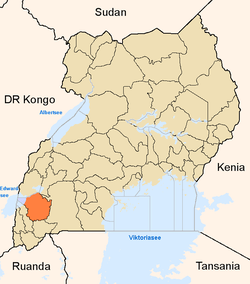Bushenyi District
| Bushenyi District | |
|---|---|
| District | |
 | |
| Coordinates: 00°33′S 30°12′E / 0.550°S 30.200°E | |
| Country |
|
| Region | Western Uganda |
| Sub-region | Ankole sub-region |
| Capital | Bushenyi |
| Population (2010 Estimate) | |
| • Total | 260,600 |
| Time zone | EAT (UTC+3) |
| Website | Homepage |
Bushenyi District is a district in Western Uganda. Like many other Ugandan districts, it is named after its 'chief town', Bushenyi, where the district headquarters are located.
Location
Bushenyi District is bordered by Rubirizi District to the northwest, Buhweju District to the northeast, Sheema District to the east, Mitooma District to the south and Rukungiri District to the west.[1] The largest town in the district, Ishaka, is located 75 kilometres (47 mi), by road, northwest of Mbarara, the largest city in the sub-region.[2] The coordinates of the district are:00 32S, 30 11E.
Overview
Prior to 2010, Bushenyi District is one of the most western of Uganda's districts, by location. It covered an area of approximately 4,292.5 square kilometres (1,657.3 sq mi), of which 8.6% was open water, 2.2% was wetland and 18.3% was protected national forest reserve.
All that changed on 1 July 2010 when, by Act of Parliament, the old Bushenyi district was split into six (6), new smaller districts, namely:
- Buhweju District
- Busheny District - New and smaller
- Mitooma District
- Rubirizi District
- Sheema District
The district is part of the larger Ankole sub-region, constisting of nine (9) districts, and home to an estimated 2.2 million Banyankole in 2002, according to the national census conducted at that time.
Population
In 2002, the district, as configured after July 2010, had a population of about 205,700, according to the national census bureau. The population growth rate in the district was estimated at 3.0%. It is estimated that the population of the district in 2010 was approximately 260,600. See table below:
| Bushenyi District Population Trends | |||||||||||||||||||||||||||||||||||
Economic activitiesBushenyi District is fairly endowed with natural resources. The district has relatively low poverty levels among its residents. The economy of the district depends mainly on agriculture. Agriculture is a source of food for the population, subsistence income for most families and provides direct employment to 86.7% of the district population, as well as supplying raw materials to industries. The majority of the people are involved in subsistence agriculture with some engaged in commercial production of crops including: Ranching for beef and dairy farming for milk production are widely practiced on both subsistence and commercial scales in Bushenyi District. Hybrid cattle are widely raised on farms in the district. The hybrids produce more milk per animal and yield more beef per carcass and therefore are more profitable that the local breeds. Soil degradation, poor marketing and processing systems, and frequent out break of crop and livestock diseases are some of the challenges that the farmers in the district face.[3] External linksSee alsoReferences
| |||||||||||||||||||||||||||||||||||